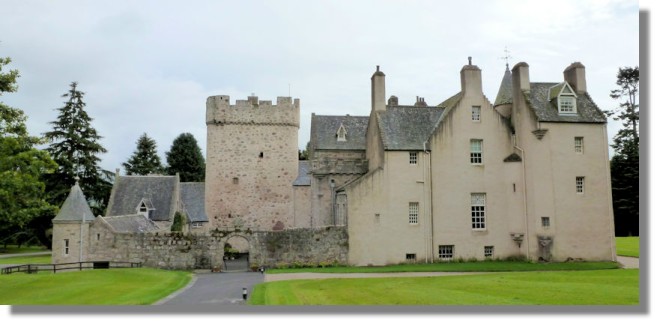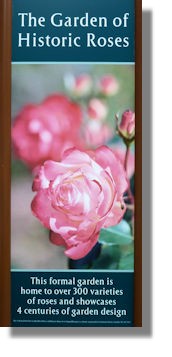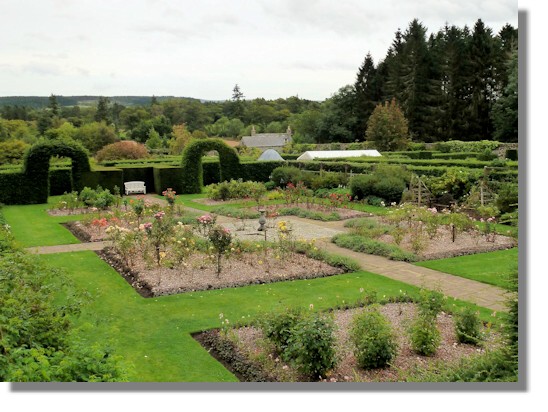
Drum Castle

Places to Visit in Scotland
- Drum Castle, AberdeenshireThe Buildings and their Owners
Drum Castle is an amalgam of a number of different styles of architecture, incorporating an ancient tower, a Jacobean mansion and a Victorian extension. The Tower of Drum was probably built in the second half of the 13th century. The keep is one of the three oldest tower houses in Scotland. The place-name Drum is derived from Gaelic druim meaning "ridge".
King Robert the Bruce appointed William Irvine as his representative in the Royal Forest of Drum and the Barony of Drum in a charter dated 1323. The Irvines continued to serve the monarch and Alexander, the fourth laird of Drum played a significant part in the negotiations which secured the release of King James I who had been held captive in London for eighteen years. The king granted him a knighthood as a result.
The ninth laird of Drum was responsible for the building of the Jacobean mansion in 1619 (see graphic on the right with the tower behind). He was so rich that he was able to lend money to King James VI and set up a scholarship at Aberdeen University (which survives to this day).
The Irvine family - and Drum Castle - suffered during the Civil War, providing support for the Royalist cause of the king. With the return of King Charles II, the eleventh laird was offered a peerage - but turned it down as the king refused to provide financial compensation for the damage caused while supporting the monarchy. The Irvines also supported the Jacobite cause and the 14th laird died at Sheriffmuir in 1715.
The Jacobean mansionhouse was built in 1619. We know this from the carving above one of the dormer windows which carry the initials of the laird (Alexander Irvine) and his wife (Marion Douglas). Unfortunately, the stone mason was not a man of letters and the 1619 was carved upside down and looks like 6191! The elegant frontage incorporates windows and a doorway, which were added in the 18th century.Financial problems led to most of the estate having to be sold off in 1736 but the seventeenth laird was still involved with the Jacobite Uprisings of 1715 (the 14th laird, also an Alexander Irvine died from wounds at the Battle of Sherrifmiur and the 17th laird (also Alexander) fought at Culloden in 1746. After hiding in a secret room in Drum he escaped to France but later returned.
In 1984, the castle and its 411 acres were bequeathed to the National Trust for Scotland by the 24th laird, bringing to an end the ownership for 24 generations by one family. That's the Irvine crest on the left which still adorns the wall of the building.
The Estate
Although at one time the estate stretched from Drumoak to Banchory and was large enough to bring the monarchs of Scotland to visit to enjoy hunting deer and wild boar, there are still areas of the Old Wood of Drum to wander around and, if you are lucky, you may catch sight of red squirrels and in the spring the woods provide locations for hundreds of nesting birds. Some of the oak trees date back to the 1700s. The arboretum contains trees from all regions of the 18th century British Empire. There is also a children's play park.
Garden of Historic Roses and Other Attractions

Drum Castle also has a walled garden (there are records of gardens at Drum going back to the mid-17th century) and in recent years this has been developed by the National Trust and includes areas which reflect the plants from the 17th, 18th, 19th and 20th centuries, incorporating a Garden of Historic Roses.
The 16th century chapel (restored in the 19th century by Alexander Forbes Irvine of Drum FRSE) and the dining hall can be hired for weddings and corporate functions. There are also special local events run by the National Trust for Scotland including classic car rallies and musical fetes.
There is also a small shop and tearoom within the castle. The castle is open to visitors - check their Web site for hours of access.

Drum Castle Garden of Historic Roses
Return to Index of Places to Visit
Where else would you like to go in Scotland?

